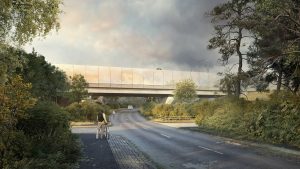Options for the appearance of Balsall Common Viaduct in the West Midlands have gone on display at community events locally so that local people are able to vote on colour, finish, and pattern designs as well as landscape. The Balsall Common Viaduct is a railway viaduct under construction in Balsall Common that will carry the HS2 line. The local community will be given the chance to vote on the appearance of a landmark HS2 viaduct near Solihull as part of the high-speed line’s commitment to inclusive design.

The viaduct is designed to sit within the surrounding landscape, and the five parapet options are designed to make the viaduct either more prominent through the use of bold colours, or less prominent by using polished concrete to reflect the sky and surroundings.
The structure is being built by HS2’s main works contractor, Balfour Beatty VINCI (BBV), supported by a Design Joint Venture of Mott MacDonald and SYSTRA together with architects Weston Williamson + Partners.
The options include a plain concrete parapet, a red, green or highly polished parapet with full length patterning, or a polished parapet with a pattern only over Station Road. There are also four options for the parapet pattern itself. These reference local history and include a weave motif to represent the history of textile production in the area, a tree motif to represent the Forest of Arden, a brick motif referencing local brickmaking and a ram’s horn motif to represent the history of livestock farming at nearby Ram’s Hall.
The innovative polished concrete parapet option is designed to allow the colour of the sky, different lighting conditions and taller local vegetation to be reflected back to the viewer. Samples and videos of this option will be available for the community to access during the consultation period.
The design includes a landscape scheme that complements the viaduct structure, helping to integrate it with existing features in its setting. The scheme retains the existing semi-open landscape character through careful placement of screening woodland for visual purposes. The scheme also aims to increase biodiversity through planting, seeding and introducing more water habitat.
People are being asked to provide feedback on three landscape design options which focus on either conserving the landscape character, planting additional woodland or creating a marshland concept.
The proposal for additional woodland planting is on the Balsall Common side of the viaduct, with more trees and shrubs around the fishing lakes to provide more screening of the viaduct. On the Berkswell side, the design builds on the network of well-maintained hedgerows with mature oak trees and strengthens the vegetation alongside Baileys Brook, also providing an additional filter to views.
The marshland concept would create a new area of wetland for plants and wildlife, increasing the biodiversity of the area. With soft ground, pools, long grasses and reeds, this option makes it difficult to approach the structure, helping prevent any potential graffiti. A series of causeways through the area would give residents access to this new habitat area, which could also be used for educational purposes.
BBV have started constructing the 16 piers which will carry the 425 metre-long viaduct up to 10 metres above ground, crossing over Station Road, Bayleys Brook, the Heart of England Way Walk and the local floodplain. Construction refinements have reduced the size of each pier by as much as 17% for single piers and 28% for double piers, giving the structure a lighter appearance.